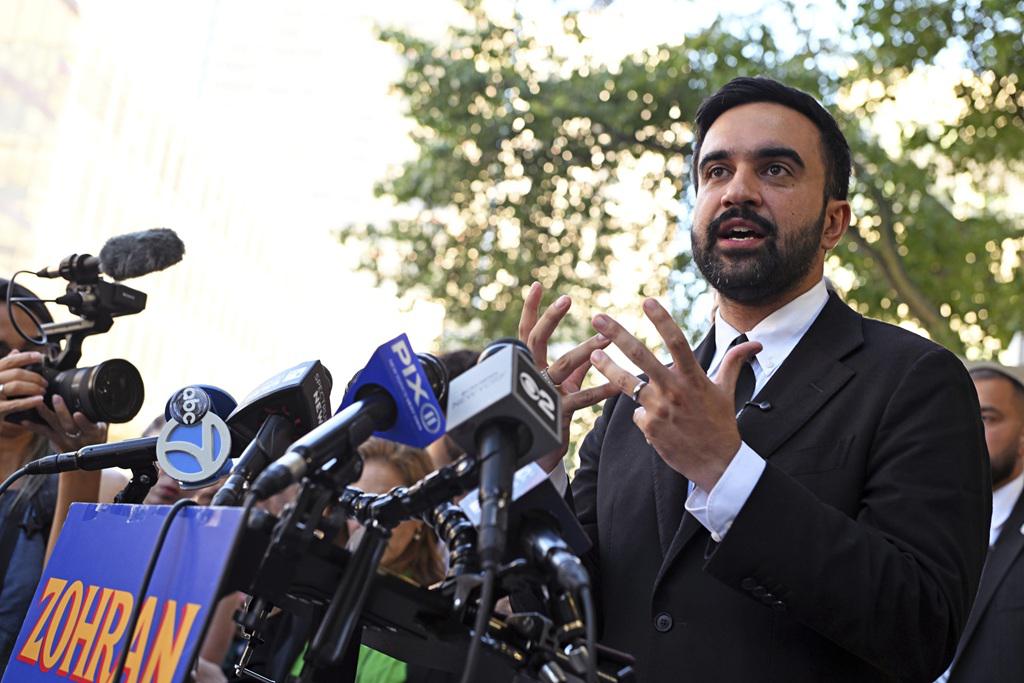By Harold Meyerson
Copyright prospect

This article appears in the October 2025 issue of The American Prospect magazine. Subscribe here.
Sixty years ago, the leaders of the civil rights movement faced an unavoidable question: What now? In successive summers, Congress had enacted the Civil Rights Act and the Voting Rights Act. The South’s de jure segregation and denial of Black citizenship were no more; the battle for equality before the law appeared to be settled. The battle for social and economic equality, however, was only just beginning.
Even before the legislative triumphs, the instigators, organizers, and leaders of the 1963 March on Washington understood that their fight had to become a much broader social revolution. On the day after the march, they convened a conference to discuss what they could do to make that happen. The conference was sponsored by the Socialist Party, which, despite its minuscule membership, contained within its ranks the instigators and organizers of the march.
The keynote speakers at the conference were the instigator, the venerable socialist A. Philip Randolph, and the organizer, Randolph’s deputy Bayard Rustin. Randolph’s socialist activism dated back to the 1910s, when his newspaper urged Blacks to oppose U.S. participation in World War I. In the 1930s, as president of the Brotherhood of Sleeping Car Porters, he astounded and alarmed business leaders and delighted Black Americans when his union won recognition and a contract from the reactionary Pullman Company. In the early 1940s, with war looming, his threat of a march on then-segregated Washington, D.C. (which 100,000 Blacks had pledged to join) compelled President Roosevelt to meet Randolph’s demand for a ban on racial discrimination in defense plants. In 1948, a similar Randolph threat compelled President Truman to order the desegregation of the armed forces.
In late 1962, Randolph and Rustin proposed a march for the following year—the 100th anniversary of the Emancipation Proclamation—centered on job creation. The Emancipation March for Jobs set a bold vision, that the civil rights struggles of Blacks “may now be the catalyst which mobilizes all workers behind the demands for a broad and fundamental program for economic justice.” But in the early spring of 1963, the nonviolent campaign to desegregate Birmingham, Alabama, led by Martin Luther King Jr., was met by a violent response from the Birmingham police, who set dogs, nightsticks, and fire hoses on children and adults, all captured on television newscasts. The ensuing uproar compelled President Kennedy to call on Congress to enact a civil rights law requiring the desegregation of private and public facilities. Randolph and Rustin added that demand—and successfully urged that the legislation also include a section requiring a ban on discrimination in employment—to their march’s agenda, which they renamed the March on Washington for Jobs and Freedom.
The class-based universalistic politics of the socialists of the 1960s and ’70s hold important lessons for the socialists of 2025.
The march, organized by Rustin, was of course a historic success, climaxing in King’s address, and providing major momentum to enact the civil rights legislation of the next two years.
At the Socialist Party’s follow-up conference, Randolph laid out his ideas for the future. Pointing out that white sharecroppers had civil rights but lived in abject poverty, he said, “We must liberate not only ourselves but our white brothers and sisters.” Rustin followed by declaring a need for economic planning that would deal with the technological unemployment he saw coming in the auto and steel plants that employed large numbers of Black men.
By 1965, after the enactment of the Civil Rights Act and the Voting Rights Act, Randolph, Rustin, and King turned even more forcefully to the economic policies they saw as imperative if Blacks were ever to achieve social as well as legal equality. They believed Lyndon Johnson’s War on Poverty, while good as far as it went, fell lamentably short of remedying the inequality hardwired into the economy. Their advocacy steered clear of programs specifically directed to help Blacks and other racial minorities, focusing instead on huge economic reforms that would, in Kennedy’s famous phrase, lift all boats.
They had ample reason to think that a white backlash would follow policies aimed only at helping racial minorities, and not just in the South. In the 1964 Democratic presidential primaries (which were held in only a handful of states), Alabama Gov. George Wallace, the nation’s foremost champion of segregation and virulent racism, took 34 percent of the vote in Wisconsin and 30 percent in Indiana.
The new civil rights laws did nothing, and the War on Poverty programs precious little, to alleviate the pervasive poverty, ghettoization, and systemic police abuse of Blacks in Northern cities. The 1965 Watts Riots made clear that those ghettos were powder kegs that needed only one more police outrage to explode. So later that year, Randolph announced that he’d “call upon the leaders of the Freedom Movement to meet together with economists and social scientists to work out a ‘Freedom Budget’” that spelled out how the nation could achieve de facto—not just de jure—equality.
RANDOLPH, RUSTIN, AND KING, standard-bearers of this Freedom Movement, were all avowed democratic socialists. Chief among the academic and union economists who worked with them on developing the budget was Leon Keyserling. As an attorney and economist on the staff of New York Sen. Robert Wagner in the 1930s, Keyserling had actually written most of the text of both the Social Security Act and the National Labor Relations Act. In the following years, he’d held multiple posts in both the Roosevelt and Truman administrations, arguing for planned full employment and higher minimum wages. (His advocacy led Truman and the Congress to enact what is still the greatest percentage increase in the federal minimum wage.)
When the Freedom Budget was released in late 1966, it called for planned full employment, income provision for those who couldn’t be employed, universal medical care, higher minimum wages, new housing to replace the nation’s 9.3 million “seriously deficient housing units,” the eradication of air and water pollution, and preservation of the nation’s natural resources, among other social necessities. It was Keyserling’s achievement that it did so without running a deficit or raising tax rates. By mandating a high level of production and planned full employment, the budget penciled out so that revenues coming in to the government would grow to provide an additional $185 billion over the next ten years that could fund its proposals, without diminishing the billions needed to fund other government activities. Full employment was the key, boosting the number of taxpayers, the level of their wages, and the government’s revenues.
We need to recall that in 1966, the highest marginal federal income tax rate was 70 percent (today, it’s 37 percent); the federal corporate tax rate was 53 percent (it’s 21 percent today); and the rate of private-sector unionization was 30 percent (it’s 6 percent today). Keyserling’s numbers were based on the more egalitarian income and tax rates in place when he wrote.
The only real way to produce a social revolution for America’s Blacks was to produce a social revolution for all Americans.
To say that the odds against the Freedom Budget’s adoption were steep is an understatement. It presupposed that the burst of liberal legislation that came out of the overwhelmingly Democratic Congress of 1965 would continue, yet the Democratic majorities were quickly diminished in the 1966 midterms. The budget also failed to account for the growing spending on the Vietnam War—and by ignoring the moral as well as financial costs of the war, it failed to reach out to and interest its most natural constituency—liberal and left-liberal anti-war activists.
With the election of Richard Nixon in 1968, hopes for any of the budget being even partly enacted abruptly ended. When Jimmy Carter recaptured the White House for the Democrats in 1976, alongside a lopsidedly Democratic Congress, a movement for full employment emerged. It was backed by the more progressive unions, embodied legislatively in the Humphrey-Hawkins bill setting full employment targets for the government, and led intellectually by socialist Michael Harrington, who argued in print and on podiums that planned full employment was the only way to create the kind of broad economic security necessary for the public to support a comprehensive progressive agenda. (Harrington explained how planned full employment in the Nordic social democracies gave those nations the political space to enact other progressive policies—feminist, environmental, and so on.) Harrington also assembled a coalition of unions and newer social movements in support of both Humphrey-Hawkins and the broader cause.
Carter and centrist Democrats in the Congress so watered down Humphrey-Hawkins, however, that the enacted version made no real impact on the nation’s economy. Still, as late as the 1992 Democratic presidential primaries, before neoliberalism had captured not just the Republicans but most of the Democratic Party as well, candidate Bill Clinton would occasionally refer to Sweden’s full employment policies as something the U.S. would do well to emulate.
WHAT REMAINS CLEAR NEARLY 60 YEARS after the Freedom Budget is the conviction of its authors—Randolph wrote its introduction, King wrote its foreword, and Rustin supervised its production—that the only real way to produce a social revolution for America’s Blacks was to produce a social revolution for all Americans. The Black nationalism, Black separatism, and Black capitalism that also began to surge once the government had struck down de jure segregation, they believed, wouldn’t and couldn’t change the contours of the nation’s economy in a way that could alleviate Black poverty. In a speech Rustin delivered shortly after the budget was unveiled, at a time when both Black nationalism and white backlash were on the rise, he said that any viable strategy had to be addressed “equally to Negro frustration and white fear.”
The Urban League’s Whitney Young eagerly endorsed the Freedom Budget, but he also backed a policy that stood in stark contrast to the budget’s universalism. He argued that the government should set quotas for hiring and advancing Blacks in public- and private-sector jobs, and in colleges and unions. An attenuated version of that proposal became a key part of various affirmative action programs, and over the years won considerable support from the one sector of white society with which the Urban League interacted most: corporate elites, who could admit Blacks and other minorities to their ranks without the kind of reversals to power relationships (and, despite Keyserling’s calculations, higher taxes) to which the Freedom Budget could lead. To be sure, Young and his successors still favored many of the social programs spelled out in the budget and subsequent progressive legislation, just as the successors to Randolph and Rustin were to support affirmative action in the absence of the kind of sweeping changes their budget called for.
But today, as Idrees Kahloon recently documented in The New Yorker, the past half-century of affirmative action and DEI have failed to move the needle in reducing the still vast gap between Black and white wealth and income. Politically, such policies were in retreat well before Donald Trump attained and then regained state power. Kahloon argues that the sole remaining path forward to reduce our soaring economic and social inequality is the kind of class-based universalism embodied in the long-forgotten Freedom Budget. I’d add that the downward mobility of the American working class in recent decades makes such universalism more politically plausible than it was in 1966.
The class-based universalistic politics of the socialists of the 1960s and ’70s hold important lessons for the socialists of 2025. One socialist who understands those lessons in his very bones is New York mayoral candidate Zohran Mamdani, whose affordability agenda steers clear of a multitude of more particularist agendas—some very worthy, some less so—in favor of policies directed at the broadest possible population of poor and working-class, middle-class, and even upper-middle-class New Yorkers. While New York city government has no real power over levels of employment, much less full employment, it does have power over municipal provision of such services as child care and rent controls.
At a time when nationalism, xenophobia, and racism are all around us, socialism certainly should be universalistic. As it happens, class-based universalism is also the most pragmatic course for progressive initiatives in America today. That Democrats of all tendencies have embraced varieties of affordability platforms illustrates the appeal of sharply drawn but universally targeted economic policies. In his class-based, universal, and very pragmatic socialism, Mamdani is the proper heir to Randolph, Rustin, and King.



